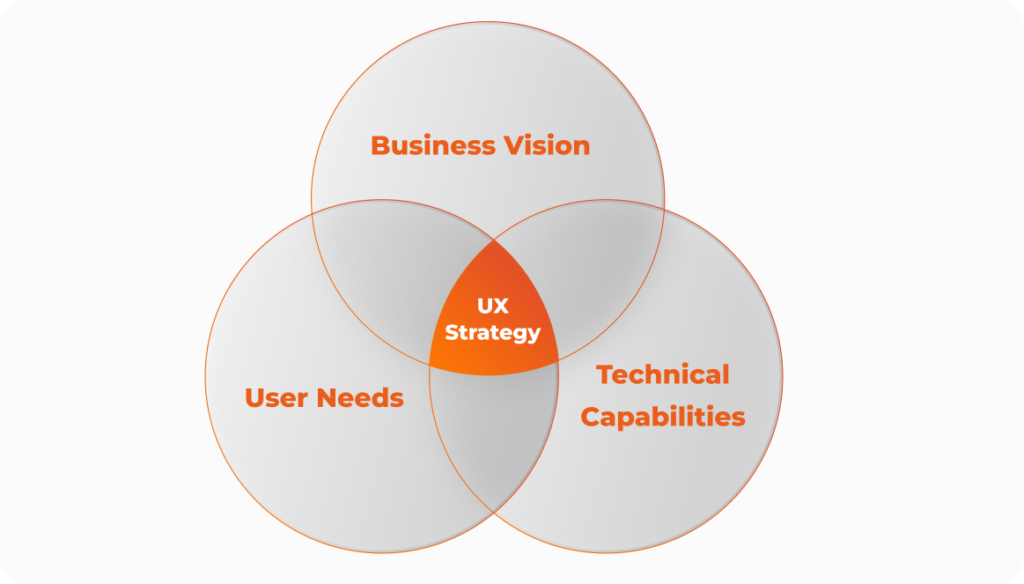Introduction
For 73% of online shoppers, user experience is more important than price or product quality when it comes to purchasing decisions. User expectations soar higher by the day, and companies that fail to meet them risk losing the competition game.
Just like a solid foundation supports a towering skyscraper, a well-thought-out user experience strategy is the backbone of exceptional digital experiences. In this article, we’ll break down what a UX strategy entails and show you how to make it work.
What is a UX strategy?
A UX design strategy is like a roadmap for creating digital products that takes into account user needs, business objectives, and technological capabilities.

The goal is to make sure that every interaction with a website, app, or product is smooth, intuitive, and enjoyable for the user, and that this interaction drives tangible business outcomes.
In her book UX Strategy, Jaime Levy gives the following definition:
“Although UX design encompasses numerous details such as visual design, content messaging, and how easy it is for a user to accomplish a task, UX strategy is the ‘Big Picture.’ It is the high-level plan to achieve one or more business goals under conditions of uncertainty.”
Get all your business goals met by our top-1% UI/UX experts
Key elements of a UX strategy
The key elements of a UX strategy can be broken down into three main groups:
Vision
This reflects your main high-level strategic objective for your product or service. It’s about envisioning what you want to achieve and what kind of experience you want users to have.
Goals
Specific milestones that you need to achieve to bring your product vision to reality. Goals help you stay focused and measure your progress along the way. They could be things like increasing user engagement, improving satisfaction, or boosting sales.
Plan
An actionable roadmap of how you’re going to reach your goals. It involves outlining the steps you’ll take, the resources you’ll need, and the timeline for achieving your objectives.
Let’s illustrate these points with the example of a mobile banking app:
Vision: To create the most seamless and convenient way for users to manage their finances on the go, providing them with easy access to account information, transactions, and financial tools.
Goals:
- Increase the average time spent on the app by 20% within six months.
- Achieve a customer satisfaction rating of 4.5 out of 5 stars within one year.
- Boost the adoption rate of the solution by 30% within five months.
Plan:
- Conduct user research to identify pain points and preferences, informing feature prioritization and design decisions.
- Develop and implement a user-friendly interface with intuitive navigation, focusing on ease of use and accessibility.
- Regularly gather user feedback through surveys, usability testing, and app analytics to iterate and improve the app based on user needs and preferences.
- Launch targeted marketing campaigns to promote new features and continually strengthen user engagement.
- Collaborate with customer support teams to address user issues promptly and enhance overall user experience.
Four tenets of a UX strategy
Jaime Levy identifies four tenets that make up the foundation of a solid UX strategy.
- Business strategy lays out a company’s big-picture plan. It includes its core beliefs, how it stands out from competitors, revenue streams, and high-level goals.
- Value innovation means finding ways to offer users something different and valuable while keeping costs down. It’s about coming up with new ideas that benefit both customers and the company.
- Validated user research involves checking that users see value in what you’re offering. This can be done through various methods like user interviews, focus groups, and more.
- Killer UX design is enjoyable and effortless to navigate, makes a product accessible to everyone, and, most importantly, solves real problems.
Why a UX strategy matters and what happens when it’s missing
A solid UX strategy offers a number of benefits, including:
- Smart prioritization. By understanding business goals and user needs, a UX strategy can help prioritize features and design solutions that drive value and achieve desired outcomes.
- Enhanced user satisfaction. By considering user needs, preferences, and pain points, designers can create interfaces that are intuitive, easy to use, and enjoyable, leading to higher user satisfaction and loyalty.
- Development costs optimization. Nielsen Norman Group states that spending 10% of a development budget on UX can boost conversions by 83%. Investing in a UX strategy upfront can help identify potential issues and opportunities early in the design process. By conducting user research, creating prototypes, and testing designs iteratively, companies can mitigate risks and avoid costly redesigns and rework later in the development cycle.
- Structured product improvements. A UX strategy establishes clear objectives and KPIs to measure the effectiveness of design solutions. By collecting and analyzing user data and feedback, organizations can iteratively improve their products and services to better meet user needs and achieve business goals over time.
The absence of a UX strategy poses significant risks to businesses, including:
- Poor decision-making. A lack of user research can lead to decision-making driven solely by business value, disregarding crucial user needs and preferences. This detachment from user-centricity may result in failed experiences and features, ultimately hindering organizational growth.
- No real user and business value. Rather than prioritizing relevant and timely objectives that align with goals, UX efforts may be diverted towards following design trends or incorporating new technologies and competitor features, neglecting real user and business value.
- Wasted resources. Without a clear plan, resources such as time, money, and manpower may be squandered. Lack of clarity can lead to duplicate UX work, inconsistencies in workflows, poor resource allocations, and disorganized team collaboration.
- Inconsistent user experience. Without a cohesive UX strategy, different parts of a product or service may lack consistency in design and functionality. Inconsistencies can confuse users, diminish trust in the brand, and negatively impact overall user experience.
Build design solutions that drive real business value
How to create a UX strategy?
Picture this: you’re hosting a themed movie marathon night with your friends. Your goal? To ensure everyone has an unforgettable time. But how to do this?
- Craft your theme – define business objectives. What are the key goals and metrics this event aims to achieve? Do you want your friends to get to know each other better in a fun way? Do you want to cheer up your friends? Do you want to celebrate something?
- Know who’s coming – identify the target audience. It’s essential to know who your guests are and what they enjoy watching. Are they die-hard action fans or do they prefer heartwarming dramedies?
- Set the mood – establish UX goals. Every movie night needs the right atmosphere. Set specific goals for your event, like creating a cozy ambiance or sparking lively discussions. These goals will guide your decisions and ensure your movie night hits all the right notes.
- Scope out the competition – perform a competitive analysis. Find out what movie night your frenemy hosted last year. Did they have a popcorn machine? Were there any themed contests? Were guests frustrated by something? Use this intel to make your event stand out.
- Map out the flow of your movie night – map user journeys. Consider how guests will navigate through different screenings and snack breaks, ensuring a seamless and enjoyable experience from start to finish.
- Popcorn or nachos? – prioritize features and functionality. Decide on the must-have features for your movie night. Will it be a DIY popcorn bar or a nacho station? This list should delight your guests and align with your goals.
- Rehearse your script – develop prototypes and test. Before the big night, run a test screening with a few friends. See how they respond to your movie choices and snack options.
- Reflect on your movie night’s success – measure and iterate. Did your friends rave about the film selection? Were they impressed by the themed decorations? Make tweaks based on guests’ feedback to ensure your next party is a success.
Wrapping up
A well-thought-out UX strategy is a necessity for any company aiming to thrive in today’s digital landscape. By aligning business objectives with user needs, prioritizing features effectively, and continuously iterating based on feedback, companies can boost user satisfaction, streamline development processes, and optimize resources.
You can easily solve any challenge with our nearshore UI/UX designers. Our team’s expertise is 50% more pocket-friendly and is praised by over 200 VC startups and Fortune 500 brands.
Stay on top of the game with custom mobile app solutions.




